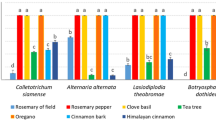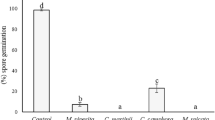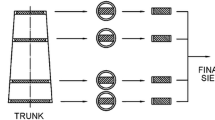Abstract
Antifungal activities of essential oils (cinnamon, clove, eucalyptus, peppermint and lemongrass oils) against moulds (Penicillium sp., Aspergillus niger and Aspergillus versicolor) isolated from rubber wood surfaces were examined. Clove oil possessed consistent antifungal activity with the minimal inhibitory concentration (MIC) of 5 μl ml−1 against all these fungi, while cinnamon oil had MICs from 2.5 to 10 μl ml−1. However, only dip treatment with cinnamon oil inhibited the growth of A. niger on rubber wood for at least 25 weeks.

Similar content being viewed by others
References
American Society for Testing and Materials (ASTM) (1998) Standard test method for fungicides for controlling sapstain and mold on unseasoned lumber (Laboratory method), vol 11.01. West Conshohocken, pp 497–500, ASTM Standard D4445-91
Chittenden C, Singh T (2011) Antifungal activity of essential oils against wood degrading fungi and their applications as wood preservatives. Int Wood Prod J 2:44–48
Clinical and Laboratory Standards Institute (CLSI) (2008) Reference method for broth dilution antifungal susceptibility testing of filamentous fungi. CLSI Approved Standard Document M38-A2. Clinical and Laboratory Standards Institute. Wayne
Jin S, Cho K-H (2011) Water extracts of cinnamon and clove exhibits potent inhibition of protein glycation and anti-atherosclerotic activity in vitro and in vivo hypolipidemic activity in zebrafish. Food Chem Toxicol 49:1521–1529
Matan N, Matan N (2007) Effect of combined cinnamon and clove oil against major moulds identified from rubberwood (Hevea brasiliensis). Walailak J Sci Technol 4:165–174
Matan N, Saengkrajang W, Matan N (2011) Antifungal activities of essential oils applied by dip-treatment on areca palm (Areca catechu) leaf sheath and persistence of their potency upon storage. Int Biodeterior Biodegrad 65:212–216
Naveed R, Hussain I, Tawab A et al (2013) Antimicrobial activity of the bioactive components of essential oils from Pakistani spices against Salmonella and other multi-drug resistant bacteria. BMC Complement Altern Med 13:265
Wang R, Wang R, Yang B (2009) Extraction of essential oils from five cinnamon leaves and identification of their volatile compound compositions. Innov Food Sci Emerg Technol 10:289–292
Acknowledgments
The authors would like to thank Plan Creations Co., Ltd., Trang, Thailand for providing rubber wood materials. We are thankful to the Thailand Research Fund (TRF) through the Royal Golden Jubilee Ph.D. Program (Grant No. PHD/0106/2552) and the Graduate School, Prince of Songkla University for the financial support. Assoc. Prof. Seppo Karrila from the Research and Development Office (RDO), Prince of Songkla University is thanked for revising the English.
Author information
Authors and Affiliations
Corresponding author
Rights and permissions
About this article
Cite this article
Ma-in, K., H-Kittikun, A. & Phongpaichit, S. Application of plant essential oils in prevention of fungal growth on Para rubber wood. Eur. J. Wood Prod. 72, 413–416 (2014). https://doi.org/10.1007/s00107-014-0790-z
Received:
Published:
Issue Date:
DOI: https://doi.org/10.1007/s00107-014-0790-z




